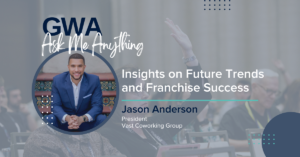When it comes to social media marketing, it can be hard to know where to start, and with Facebook constantly updating its algorithms, the process of developing a Facebook ad campaign that actually converts can be a daunting task.
Recently, Jordan Choo, Managing Partner at Kogneta, sat down with the Global Workspace Association to share an overview of how to run successful Facebook ad campaigns for your site. His expertise—drawn from a ten-year career in digital marketing, helping local coworking brands find a retain customers—offered a number of easily implemented tips and tricks for Facebook marketing for coworking.
And it all comes down to a simple equation: Audience + Ads + Call to Action = profit
Do Facebook Paid Ads Work?
One of the first major decisions in Facebook marketing is whether to focus on paid or organic (free) marketing strategies. While organic advertising might be easier on your budget, Choo said that, unfortunately, the numbers don’t make most of it worth your staff’s time.
Only about six percent of a page’s followers actually see an organic post—and those who haven’t liked your page are unlikely to see it at all.
“Marketing on Facebook is now pay-to-play,” Choo said.
Audience: Why Facebook Advertising?
If no one sees your organic posts anyway, is it even worth having a page?
Choo thinks so. He explained that while online marketing through platforms like Google AdWords can help people who are already searching for your space (or a coworking space in general), Facebook can target a variety of audiences at different points on your sales funnel.
“You’re able to target anyone and everyone across the globe, whether they like your page or not,” Choo said.
Choo explained audience on a sliding scale:
- Hot audience – Audience demographics built from data you already own.
- Warm audience – Look-alike audiences from “similar matches” Facebook’s AI can build via the data listed above.
- Cold audience – Audience members you haven’t made contact with and who may or may not be familiar with coworking.
Facebook’s ad targeting allows high levels of specificity within each of these groups, allowing you to track metrics by age, device type, education level, industry, location—any of the factors you would need to be sure you’re targeting your ideal client and altering your marketing based on the segments that are most successful.
To take advantage of this data collection ability, however, you need to be sure to have Pixels integrated into your website and social media—something your web developer should be able to help with, Choo said.
Types of Facebook Ads
It’s not enough to know your audience demographics, however; you also need to tailor your ads to that audience.
Choo suggests placing a priority on “hot” audiences—audiences that are likely to convert—but as you diversify to try to target other levels of your sales funnel. It’s important to remember that whatever you do, you need to tailor the ad to what your target demographic will want to see.
For example, your “hot” audience members don’t need to see ads for booking a tour, since they’re likely already interested in your brand. Instead, create ads that market membership packages, amenities, etc.
Although Facebook ad types vary by purpose, the basic components of an ad do not, Choo explained:
- Text: Don’t make your ad text too long but do make sure it focuses on the specific benefits of your space that would be attractive to your target audience as well as explicitly addressing the pain points of that same group. This means you can’t just write one ad for all your Facebook marketing.
- Media: Some Facebook ads just have an image, some use video, and some use image carousels. Whatever media you choose to use, make sure no more than 20 percent of it is covered in text. Be sure, too, that the photos allow your target audience to picture themselves taking the action you’re trying to motivate them toward (working in your space, going on a tour, etc.).
- Headline, link description, and URL: Make sure your URLs hint at what the user will find if they click on your ad. Make sure the headline and link descriptions are succinct and to the point, but also give the reader a clear idea of what they will find when they click the ad.
- Call to Action: This is one of the most important parts of the post, and Facebook will give you several options for what call to action to put. Choo said to think of the ad as a promise to the reader: they should know what they will find when they click the link, and the URL should take them directly to that page.
When running some kind of special offer ad, Choo also suggested creating unique codes or landing pages to track which demographics respond best to your offers. This kind of data can tie into Pixels integration and will be helpful whether you’re ready to revamp your Facebook marketing right now or later. Collecting data now will make marketing easier later, Choo explained.
Getting Started with Facebook Marketing
Wherever you are in the process of figuring out the Facebook algorithms, make sure you’re tracking the conversions per dollar—and don’t forget to factor in staff time. While organic posting to your page can be important in terms of community building, having staff spend large amounts of time on it tends to be counterproductive.
If you’re just getting started, Choo said he recommends a starting budget of $10 per day for Facebook marketing (keep in mind that other platforms, such as LinkedIn, charge much higher rates for advertising and thus may be a less attractive option for your space). You can always raise or lower your budget from there.
If you’re looking for more resources to help you with marketing—including options for custom-written marketing content, consider checking out the members-only resources from the Global Workspace Association.




